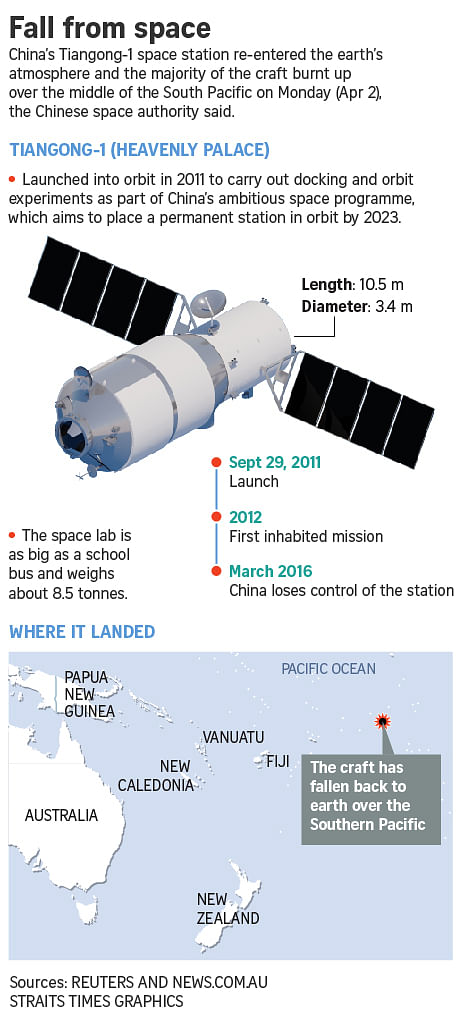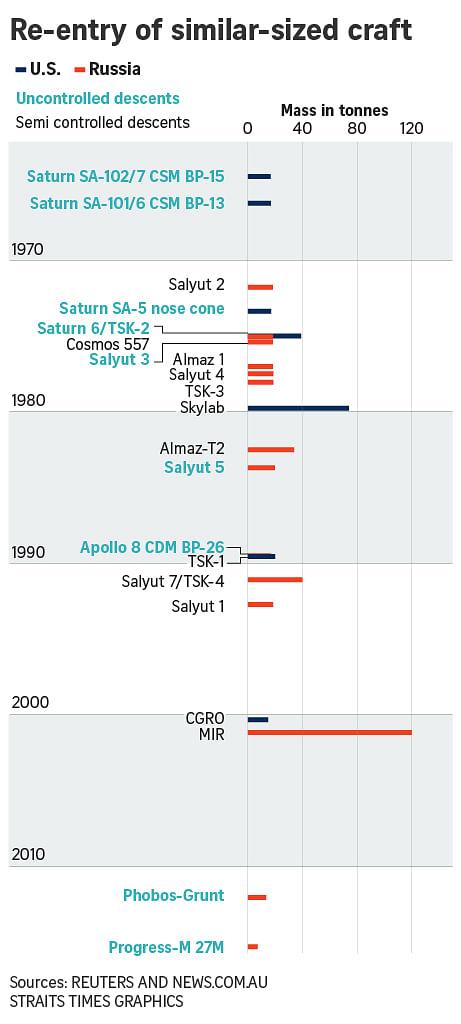BEIJING (AFP, REUTERS) - A defunct Chinese space lab plunged through Earth's atmosphere Monday (Apr 2), breaking apart as it headed towards a watery grave in the South Pacific, Beijing said.
The Tiangong-1 "mostly" burnt up above the vast ocean's central region at 8.15am, China's Manned Space Engineering Office said, moments after predicting a slightly later re-entry over the Atlantic.
Space officials had stressed that the craft would not cause any earthly damage when it returned, with Chinese space officials saying its disintegration will offer a "splendid" show akin to a meteor shower.
Asked about the space station, Chinese foreign ministry spokesman Geng Shuang told a regular briefing he had no other information and reiterated that China had been reporting the situation to the UN space agency in an open and transparent way.
"According to what I understand, at present there has not been found any damage on the ground," he said, without elaborating.
The United States Air Force 18th Space Control Squadron, which tracks and detects all artificial objects in earth's orbit, said they had also tracked the Tiangong-1 as it re-entered the atmosphere over the South Pacific.
It said in a statement they had confirmed re-entry in coordination with counterparts in Australia, Canada, France, Germany, Italy, Japan, South Korea and Britain.
Space officials had warned that knowing the exact location of the re-entry would not be possible until shortly before it happened, and China's space agency had predicted it would be off Sao Paulo just moments before the Tiangong-1 made its actual return.
The European Space Agency had indicated earlier that the Tiangong-1 was likely to break up over water, which covers most of the planet's surface.
It described the probability of someone being hit by a piece of debris from Tiangong-1 as "10 million times smaller than the yearly chance of being hit by lightning".
The remnants of Tiangong-1 appeared to have landed about 100 km northwest of Tahiti, said Brad Tucker, an astrophysicist at Australian National University.

"Small bits definitely will have made it to the surface," he told Reuters, adding that while about 90 percent would have burnt up in the atmosphere and just 10 percent made it to the ground, that fraction still amounted to 700 kg to 800 kg.
"Most likely the debris is in the ocean, and even if people stumbled over it, it would just look like rubbish in the ocean and be spread over a huge area of thousands of square kilometres." Beijing said on Friday it was unlikely any large pieces would reach the ground.
Tiangong-1 - or "Heavenly Palace" - was placed in orbit in September 2011, an important step in China's efforts towards building its own space station.
The module - which was used to practise complicated manual and automatic docking techniques - was originally intended to be used for just two years, but ended up serving considerably longer.
During its brief lifespan, it hosted Chinese astronauts on several occasions as they performed experiments and even taught a class that was broadcast into schools across the country.
Out of control?
Tiangong-1 had been slated for a controlled re-entry, but ceased functioning in March 2016. Space enthusiasts have been bracing for its return ever since.
The ESA has said that ground controllers were no longer able to command Tiangong-1 to fire its on-board engines, which could have been used to control where it re-entered Earth's atmosphere.
In contrast, Russia brought down its massive Mir space station through a controlled re-entry over the Pacific Ocean in 2001.
A Chinese spaceflight engineer denied earlier this year that the lab was out of control.

Chinese media have downplayed comments by the ESA and others that the country's engineers have lost control of the lab, with reports saying that the idea it is "out of control" is an invention of foreign media.
But on Chinese social media, commenters criticised the government's reluctance to own up to the situation.
"Can you or can't you report that you've lost control of the situation?" one person wrote on the Twitter-like Weibo.
"It's not unusual that something this complicated would have a mishap." Beijing began its manned spaceflight programme in 1990 after buying Russian technology that enabled it to become the third country with the ability to launch humans into space, following the former Soviet Union and the United States.
China sent another space lab, Tiangong-2, into orbit in September 2016 as a stepping stone to its goal of having a crewed space station by 2022.
It also plans to send a manned mission to the moon in the future.

